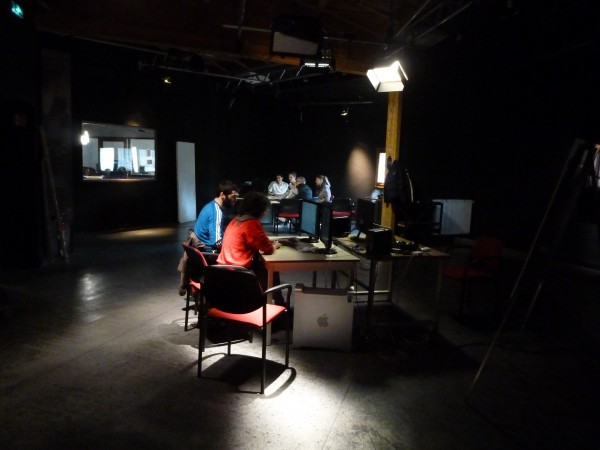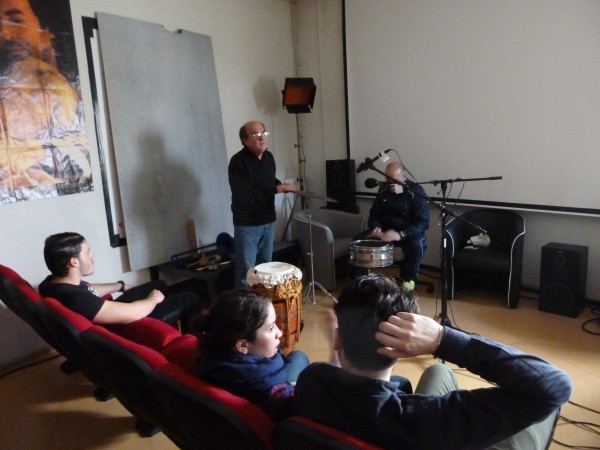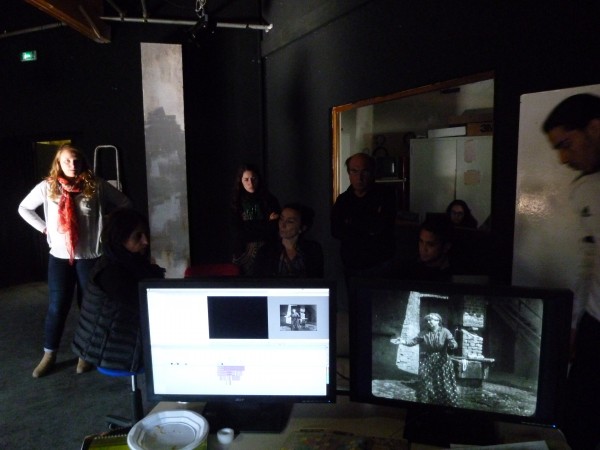Artistic experiences - process
Image’s plastic material and experimental writing work – Marseille
Place of the workshop: Cinema studio inside Marseille’s prison
Partners involved:
Lieux Fictifs:
– Caroline Caccavale, film director and trainer
РJoseph C̩sarini, film director and trainer
– Emmanuelle Raynaut, visual artist and trainer,
– Lucien Bertolina, sound composer and trainer,
– Pascal Rehnolt, editing assistant
And Pascal Césaro (head of the Documentary Film Master, Aix-Marseille University)
Westerdals, Oslo School of Arts, Communication and Technology:
– Morten Thomte, teacher
Fondazione Cineteca Italiana :
– Roberto Della Torre, head archivist
– Marcello Seregni, archivist
Publics and audiences involved:
Eight inmates participating to Lieux Fictifs film training workshops inside Marseille’s prison
Three students from Westerdals (Norway)
Three students from Master Documentary film from Aix-Marseille University
Methodology proposed:
Work around the plastic material of the image, and experimental writing work.
Creation of short films made from archive images
Archives used : Archives from Italian cinema (fiction films from the beginning of silent movies, and war newsreel between 1912 and 1920).
Results : 3 short films of 3 to 5 minutes length: « Le trou » / « The hole » – « La marche » / « The March « / « Time less variations »« Variations intemporelles »
Summary of the methodology proposed:
The first proposal made to participants was to use archive images from the beginning of Italian film, through a plastic and sensitive writing. The aim was not to work on a narration writing, not to use text, neither voice-over, but to consider image as a living material.
For all the participants, making a film by breaking narration and not leaning on a narrative, with the traditional meaning of a story to tell, has been an unsettling approach. This destabilization enabled building a common base that put all participants on an equal footing.
Beyond the work on archive image, the issue of this workshop was within the collaborative writing, knowing that participants were from different cultures, languages and social backgrounds. It was then necessary to build a playground and meeting point beyond the language and pre-existing social codes: this has been facilitated by the common editing tool. According to the axis of image transformation, each group has been able to free itself from any narrative constraint and to build its own experimental language.
Lieu : Centre pénitentiaire de Marseille
Partenaires impliquées :
Lieux Fictifs:Â
РCaroline Caccavale, r̩alisatrice et formatrice,
РJoseph C̩sarini, r̩alisateur et formateur,
– Emmanuelle Raynaut, artiste visuelle et formatrice,
– Lucien Bertolina, compositeur sonore et formateur,
– Pascal Rehnolt, assistante monteur
Et Pascal Cesaro, enseignant (Master Film documentaire, Aix-Marseille Université)
Westerdals, Oslo School of Arts, Communication and Technology :
– Morten Thomte, enseignant
Fondazione Cineteca Italiana :
– Â Roberto Della Torre, chef archiviste
– Marcello Seregni, archiviste et documentaliste
Publics et territoires impliqués :
Huit personnes détenues stagiaires des ateliers de formation et création audiovisuelle menés par Lieux Fictifs au CP de Marseille, Trois étudiants du Master Film documentaire d’Aix-Marseille Université
Trois étudiants de Westerdals School of Arts, Communication and Technology
Méthodologie proposée :
Création en groupe de court-métrages à partir d’images d’archive.
Travail sur la matière plastique de l’image, travail d’écriture expérimentale.
Archives utilisées: Images d’archive du cinéma italien (fiction du début du cinéma muet et documentaire d’actualités de guerre entre 1912 et 1920) issues du fonds de la Fondazione Cineteca Italiana.
Résultats du workshop : Trois court-métrage d’une durée de trois à cinq minutes: « Le trou », « La marche », « Variations intemporelles »
Résumé de la méthodologie proposée :
La proposition de départ faite aux participants était d’utiliser les images d’archives du début du cinéma italien à travers une écriture plastique et sensible. La proposition faite aux participants était de ne pas travailler sur une écriture narrative, de ne pas utiliser de texte, ni de voix off, mais d’appréhender l’image comme une matière vivante.
Pour l’ensemble des participants, réaliser un film en cassant la narration et en ne s’appuyant sur aucun récit, au sens traditionnel d’une d’histoire à raconter, a été une approche très déstabilisante. Cette déstabilisation a permis de construire un socle commun qui a mis l’ensemble des participants sur un pied d’égalité.
Au-delà du travail sur l’image d’archive, l’enjeu de ce workshop se situait au niveau de l’écriture collaborative, sachant que les participants étaient tous de culture, de milieux sociaux et de langues différentes. Il fallait donc construire un espace de jeu et de rencontre au-delà du langage et des codes pré-établis, chose facilité par l’outil de montage commun. Selon l’axe de la transformation de l’image, chaque groupe a pu se libérer de toute contrainte narrative et inventer un langage expérimental propre.



